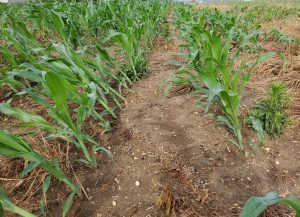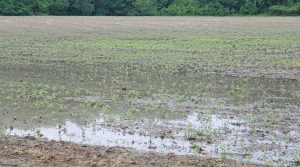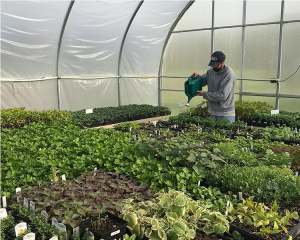2021 Vegetable IPM Program Personnel
Kris Holmstrom and Joe Ingerson-Mahar would like to acknowledge the IPM Field Technicians for this season:
Rhea Bolar
Claire Chapeau
Jeff Kane
Jake Newcombe
Gabriel Torres
Without the assistance of these individuals, much of the information presented in this publication would be unobtainable. We are grateful for all their help and hard work.
Sweet Corn
Low numbers of European corn borer (ECB) moths continue to be captured in parts of the state. Hot weather over the past week has not increased catches, indicating that this initial flight may be nearing its’ end. The highest adult activity is currently Gloucester and western Burlington counties (see map at right). Whorl corn is the primary target for egg laying, and injury as high as 18% of plants infested has been found in Hunterdon County this week. It is typical for feeding percentages to rise as the moth catch declines. We expect feeding to increase for the next 1-2 weeks before peaking.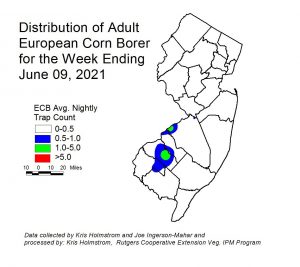
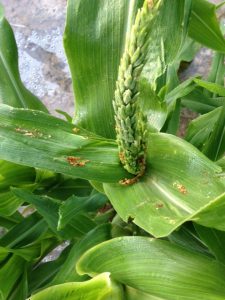 Look for the characteristic “shot-hole” type of feeding (photo below at right) and consider treating when infested plants exceed 12% in a 50 plant sample. As plantings proceed to the pre-tassel stage, ECB larvae may be found in emerging tassels (see photo at left). It is a good idea to treat individual plantings as they move into the full tassel/first silk stage one time. This eliminates any ECB larvae that have emerged with the tassels as they begin to move down the stalk to re-enter near developing ears.
Look for the characteristic “shot-hole” type of feeding (photo below at right) and consider treating when infested plants exceed 12% in a 50 plant sample. As plantings proceed to the pre-tassel stage, ECB larvae may be found in emerging tassels (see photo at left). It is a good idea to treat individual plantings as they move into the full tassel/first silk stage one time. This eliminates any ECB larvae that have emerged with the tassels as they begin to move down the stalk to re-enter near developing ears.
Useful insecticides for this particular application include synthetic 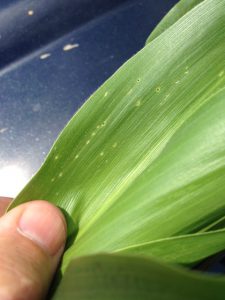 pyrethroids (IRAC Grp 3), spinosyns (including OMRI approved Entrust) IRAC Grp 5), and diamides such as Coragen or Vantacor (IRAC Grp 28) or materials such as Besiege which include the active ingredient in Coragen. Synthetic pyrethroids alone should NOT be used for corn earworm (CEW) protection on silking corn. Control with these materials is very inconsistent.
pyrethroids (IRAC Grp 3), spinosyns (including OMRI approved Entrust) IRAC Grp 5), and diamides such as Coragen or Vantacor (IRAC Grp 28) or materials such as Besiege which include the active ingredient in Coragen. Synthetic pyrethroids alone should NOT be used for corn earworm (CEW) protection on silking corn. Control with these materials is very inconsistent.
The highest nightly trap catches of ECB for the week ending 6/09/21 are as follows:
| Cinnaminson 2 | Centerton 1 | Green Creek 1 |
| Downer 2 | Crosswicks 1 | Milford 1 |
| Asbury 1 | East Vineland 1 | Oldwick 1 |
| Califon 1 | Eldora 1 | Sergeantsville 1 |
